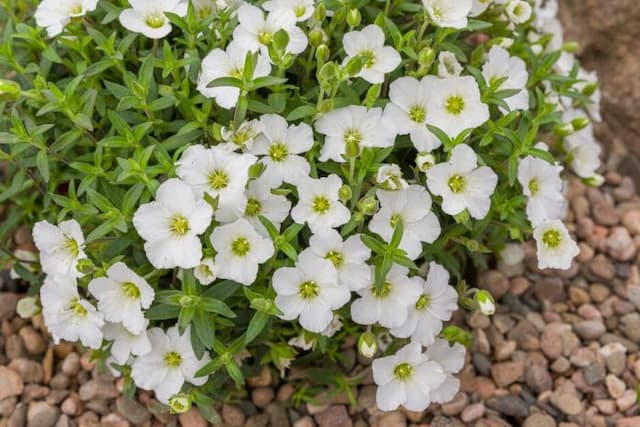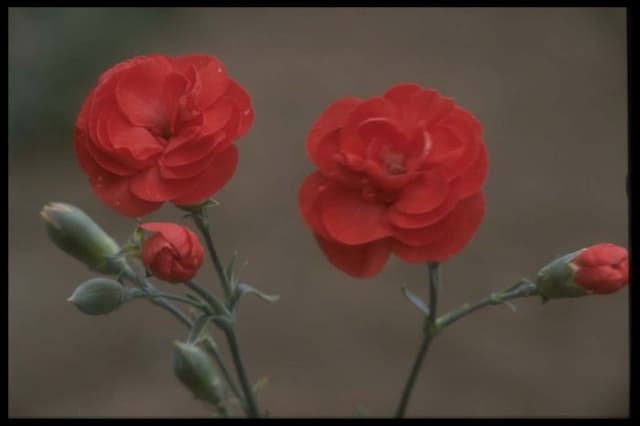Neon Star Dianthus Dianthus 'Neon Star' (PBR) (p)

ABOUT
Dianthus 'Neon Star', also known as the "Pinks", is a vibrant and colorful perennial plant known for its striking appearance. This plant boasts a profusion of bright, neon-pink flowers that provide a neon-like glow to the garden setting. Each flower is intricately constructed with frilled edges, giving them a ruffled look that adds texture and visual interest. The petals are often marked with unique patterns or have a contrasting eye that draws the eye to the center of the flower. These blossoms sit atop slender, sturdy stems that rise above the plant's compact, mounded foliage. The foliage of the Pinks is equally noteworthy with narrow, linear leaves that have a blue-green or grayish hue, which nicely complements the vivid pink flowers. The leaves are typically grass-like in appearance and form a dense, tufted clump. Together, the striking flowers and attractive foliage of Dianthus 'Neon Star' make it a standout choice for adding a burst of color and texture to rock gardens, borders, or containers. Despite its vibrant look, the size details of this plant remain unremarked, focusing solely on its visual characteristics.
About this plant
 Names
NamesSynonyms
Neon Star Pink, Neon Star Dianthus
Common names
Dianthus 'Neon Star'.
 Toxicity
ToxicityTo humans
The plant commonly known as Pinks is not considered toxic to humans. Therefore, ingesting parts of the Pinks plant typically does not result in poisoning or toxic symptoms.
To pets
Pinks are not known to be toxic to pets. Ingesting parts of the Pinks plant generally does not cause toxic reactions or symptoms of poisoning in animals such as dogs and cats. However, individual animals may have different sensitivities, and it's always a good idea to prevent pets from eating plants as a precaution.
 Characteristics
CharacteristicsLife cycle
Perennials
Foliage type
Evergreen
Color of leaves
Blue-green
Flower color
Pink
Height
8 inches (20 cm)
Spread
12 inches (30 cm)
Plant type
Herb
Hardiness zones
6
Native area
Europe
Benefits
 General Benefits
General Benefits- Compact Size: Ideal for smaller gardens, borders, and containers due to its neat growth habit.
- Long Blooming Period: Offers a succession of vibrant pink flowers that can bloom from late spring to early fall.
- Attracts Pollinators: Helps support local ecosystems by attracting bees and butterflies.
- Low Maintenance: Requires minimal care once established, making it a good choice for busy gardeners.
- Drought Tolerance: Once established, it has good drought resistance, reducing the need for frequent watering.
- Deer Resistance: Less likely to be eaten by deer, preserving the beauty of your garden.
- Cold Hardy: Capable of surviving in cooler climates, making it suitable for a range of geographical locations.
- Evergreen Foliage: Provides year-round interest with its evergreen leaves, even when not in bloom.
- Aesthetic Appeal: Adds a splash of color and texture to garden spaces with its neon pink petals and bluish-green foliage.
 Medical Properties
Medical PropertiesThis plant is not used for medical purposes.
 Air-purifying Qualities
Air-purifying QualitiesThis plant is not specifically known for air purifying qualities.
 Other Uses
Other Uses- Edible Decoration: The petals of the 'Neon Star' Dianthus are edible and can be used to garnish desserts, salads, or drinks for a splash of color and a hint of spice.
- Crafting Potpourri: Dried petals and leaves from the 'Neon Star' Dianthus can be incorporated into homemade potpourri mixes to provide a pleasant fragrance to indoor spaces.
- Natural Fabric Dye: The bright flowers of the 'Neon Star' Dianthus can be used as a natural dye for fabrics, imparting subtle hues to textiles.
- Garden Design: Its bright, neon pink color and compact shape make 'Neon Star' Dianthus appropriate for colorful groundcover or border planting in garden design.
- Floral Jewelry: Fresh or dried 'Neon Star' Dianthus flowers can be used to create unique pieces of floral jewelry, like earrings or hairpins.
- Photography Prop: The vibrant flowers can serve as a stunning photography prop, adding natural beauty and a pop of color to photo shoots.
- Companion Planting: 'Neon Star' Dianthus can be used in companion planting to help attract beneficial insects, such as pollinators, to gardens.
- Education and Science: These plants can serve as a living specimen for educational purposes, teaching about plant growth, reproduction, and the importance of pollinators.
- Natural Confetti: Petals from the 'Neon Star' Dianthus can be tossed as biodegradable, eco-friendly confetti for outdoor celebrations.
- Ice Cubes: Petals can be frozen in ice cubes to create visually appealing drinks for summer parties or special occasions.
Interesting Facts
 Feng Shui
Feng ShuiThe Pink is not used in Feng Shui practice.
 Zodiac Sign Compitability
Zodiac Sign CompitabilityThe Pink is not used in astrology practice.
 Plant Symbolism
Plant Symbolism- Love: The Dianthus, commonly referred to as 'Carnation' or 'Pinks,' has a historical association with love and admiration. Its colorful blossoms and enduring nature symbolize a deep affection that is both passionate and platonic.
- Distinction: The name Dianthus itself comes from the Greek words 'dios' (god) and 'anthos' (flower), suggesting a flower of divine or noble status. It represents recognition and high esteem.
- Pureness: The bright colors of the Dianthus 'Neon Star' radiate purity and innocence, often relating to the theme of a love that is untainted and sincere.
- Gratitude: Given as a token of thanks, the Dianthus expresses gratitude. Its lasting scent and beauty are reminiscent of cherished memories and acts of kindness.
- Boldness: The 'Neon Star' cultivar, with its striking appearance, embodies boldness and daring, encouraging individuals to stand out and embrace their unique qualities.
 Water
WaterPinks require consistent moisture, but they do not like to sit in wet soil. For Dianthus 'Neon Star', water deeply whenever the top inch of soil feels dry to the touch. Typically, this may be once or twice a week depending on weather conditions, with less frequent watering during cooler months and more in the heat of summer. Aim to provide the equivalent of 1 inch of rainfall per week, which approximately translates to 0.623 gallons per square foot. During extended dry spells, you may need to increase watering slightly, but always check the soil moisture first to avoid overwatering.
 Light
LightPinks thrive best in full sun conditions, which means they need a minimum of six hours of direct sunlight every day. For optimal growth of Dianthus 'Neon Star', choose a location where the plant will receive unobstructed sunlight for the better part of the day. However, if you live in a region with extremely hot summers, providing some afternoon shade can help protect the plant from intense heat.
 Temperature
TemperaturePinks do well in a wide range of temperatures, but Dianthus 'Neon Star' prefers moderate conditions. The ideal temperature range for this plant is between 60°F to 75°F. It can tolerate temperatures down to about 40°F and can generally handle brief periods of cold down to about -20°F, though extended freezing temperatures can be harmful.
 Pruning
PruningPruning is essential for Pinks to encourage bushier growth and more blooms. Trim back Dianthus 'Neon Star' after the initial flush of flowers has faded to promote a second bloom. Remove spent flowers and any dead or yellowing foliage to maintain plant health and appearance. The best time to prune for shaping is in early spring, just before new growth begins.
 Cleaning
CleaningAs needed
 Soil
SoilThe best soil mix for Pink Dianthus 'Neon Star' should be well-drained with a mix of loam, compost, and a bit of sand to improve drainage. The soil pH should be slightly alkaline, between 6.7 and 7.3, to promote healthy growth and vibrant blooms.
 Repotting
RepottingPink Dianthus 'Neon Star' typically does not require frequent repotting and can be repotted every 2-3 years or when it significantly outgrows its current container. Springtime is the best period for repotting to allow the plant to establish in the new pot before the growing season.
 Humidity & Misting
Humidity & MistingPink Dianthus 'Neon Star' prefers moderate humidity levels but is quite adaptable. It thrives best when humidity levels are between 40-60%. Avoid extremely high humidity as it can lead to pest issues and disease in the plant.
 Suitable locations
Suitable locationsIndoor
Ensure bright light, and well-draining soil; keep room cool.
Outdoor
Full sun and good drainage; protect from winter wetness.
Hardiness zone
6-9 USDA
 Life cycle
Life cycleDianthus 'Neon Star', commonly known as pinks, begins its life cycle as a seed or may be propagated vegetatively from cuttings. After germination, the seedling stage involves the development of a basic root system and a set of true leaves, enabling the young plant to photosynthesize and grow. As it matures into the vegetative stage, the plant develops a fuller, bushier form with stronger stems and more foliage. The flowering stage follows, where vibrant pink blossoms are produced, often in late spring to early summer, attracting pollinators to the garden. After pollination, the plant may produce seeds in capsules, completing the reproductive cycle. Finally, as a perennial, Dianthus 'Neon Star' enters a period of dormancy during colder months, only to regrow from its root system with the return of favorable conditions in the next growing season.
 Propogation
PropogationPropogation time
Spring-Early Summer
Dianthus 'Neon Star', commonly known as pinks, can be propagated most effectively through the method of cuttings. This practice is best carried out in late spring or early summer when the plant's growth is most vigorous. To propagate by cuttings, a gardener should select healthy non-flowering shoots and cut segments that are about 3 to 4 inches long. It's important to make a clean cut just below a leaf node, as this is where roots are most likely to form. The lower leaves should be removed, and the cut end of the shoot can be dipped in rooting hormone powder to facilitate root growth. The prepared cuttings are then inserted into a well-draining soil mix and kept moist until they root, which usually takes several weeks. After rooting, the new plants can be transplanted into individual pots or directly into the garden.


![Pink [Tequila Sunrise]](/_next/image?url=https%3A%2F%2Fplants-admin.emdemapps.com%2Fimages%2Fplants%2F%2Fimages%2F604b5d995d06e.png&w=640&q=75)






